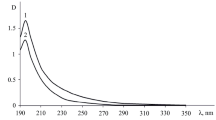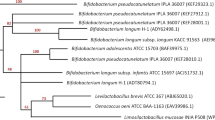Abstract
Non-covalent interaction of alcohol dehydrogenase with polysaccharides was studied using three neutral and three anionic polysaccharides. The process of interaction of alcohol dehydrogenase with gum Arabic was optimized with respect to the ratio of enzyme to gum Arabic, pH, and molarity of buffer. Alcohol dehydrogenase–gum Arabic complex formed under optimized conditions showed 93 % retention of original activity with enhanced thermal and pH stability. Lower inactivation rate constant of alcohol dehydrogenase–gum Arabic complex within the temperature range of 45 to 60 °C implied its better stability. Half-life of alcohol dehydrogenase–gum Arabic complex was higher than that of free alcohol dehydrogenase. A slight increment was observed in kinetic constants (K m and V max) of gum Arabic-complexed alcohol dehydrogenase which may be due to interference by gum Arabic for the binding of substrate to the enzyme. Helix to turn conversion was observed in complexed alcohol dehydrogenase as compared to free alcohol dehydrogenase which may be responsible for observed stability enhancement.









Similar content being viewed by others
References
Altikatoglu M, Kuzu H (2010) Improvement of enzyme stability via non-covalent complex formation with dextran against temperature and storage lifetime. Pol J Chem Technol 12:12–16
Amini K, Sorouraddin MH, Rashidi MR (2011) Activity and stability of rat liver xanthine oxidase in the presence of pyridine. Can J Chem 89:1–7
Bolivar JM, Wilson L, Ferrarotti SA, Guisan JM, Fernandez-Lafuente R, Mateo C (2006) Improvement of the stability of alcohol dehydrogenase by covalent immobilization on glyoxyl agarose. J Biotechnol 125:85–94
Bolivar JM, Rocha-Martin J, Mateo C, Guisan JM (2012) Stabilization of a highly active but unstable alcohol dehydrogenase from yeast using immobilization and post immobilization techniques. Process Biochem 47:679–686
Cray JA, Russell JT, Timson DJ, Singhal RS, Hallsworth JE (2013) A universal measure of chaotropicity and kosmotropicity. Environ Microbiol 15(1):287–296
Darias R, Villalonga R (2001) Functional stabilization of cellulase by covalent modification with chitosan. J Chem Technol Biotechnol 76:489–493
Fágáin CO (2003) Enzyme stabilization—recent experimental progress review. Enzym Microb Technol 33:137–149
Gomez L, Ramirez HL, Villalonga R (2000) Stabilization of invertase by modification of sugar chains with chitosan. Biotechnol Lett 22:347–350
Jadhav SB, Singhal RS (2012) Conjugation of α-amylase with dextran for enhanced stability: process details, kinetics and structural analysis. Carbohydr Polym 90:1811–1817
Jadhav SB, Singhal RS (2013) Screening of polysaccharides for preparation of α-amylase conjugate to enhance stability and storage life. Carbohydr Polym 92:1724–1729
Kagi JHR, Vallee BL (1960) The role of zinc in alcohol dehydrogenase. J Biol Chem 235:3188–3192
Kosjek B, Stampfer W, Pogorevc M, Goessler W, Faber K, Kroutil W (2004) Purification and characterization of a chemotolerant alcohol dehydrogenase applicable to coupled redox reactions. Biotechnol Bioeng 86:55–62
Kroutil W, Mang H, Edegger K, Faber K (2004) Recent advances in the biocatalytic reduction of ketones oxidation of sec-alcohols. Curr Opin Chem Biol 8:120–126
Kruif CG, Tuinier R (2001) Polysaccharide protein interactions. Food Hydrocoll 15:555–563
Kruif CG, Weinbreck F, Vries R (2004) Complex coacervation of proteins and anionic polysaccharides. Curr Opin Colloid Interface 9:340–349
Li G, Zhou Z, Li Y, Huang K, Zhong M (2010a) Surface functionalization of chitosan coated magnetic nanoparticles for covalent immobilization of yeast alcohol dehydrogenase from Saccharomyces cerevisiae. J Magn Magn Mater 322:3862–3868
Li J, Jiang Z, Wu H, Liang Y, Liang Y, Liu J (2010b) Enzyme-polysaccharide interaction and its influence on enzyme activity and stability. Carbohydr Polym 82:160–166
Lowry OH, Rosebrough NJ, Farr AL, Randall RJ (1951) Protein measurement with the Folin-Phenol reagents. J Biol Chem 193:265–275
Martinez DA, Nudel BC (2002) The improvement of lipase secretion and stability by addition of inert compounds into Acenatobacter calcoaceticus cultures. Can J Microbiol 48:1056–1061
Matsuda T, Yamanaka R, Nakamura K (2009) Recent progress in biocatalysis for asymmetric oxidation and reduction. Tetrahedron Asymmetry 20:513–557
Mc Arthur SL, Mc Lean KM, Kingshott P, St John HAW, Chatelier RC, Griesser HJ (2000) Effect of polysaccharide structure on protein adsorption. Colloids Surf B 17:37–48
Mc Clements DJ (2006) Non-covalent interactions between proteins and polysaccharides. Biotechnol Adv 24:621–625
Misloviacova D, Masarova J, Bucko M, Gemciner P (2006) Stability of penicillin G acylase modified with various polysacchairdes. Enzym Microb Technol 39:579–585
Patino JMR, Pilosof AMR (2011) Protein-polysaccharide interaction at fluid interfaces. Food Hydrocoll 25:1925–1937
Perczel A, Foxman BM, Fasman GD (1992) How reverse turns may mediate the formation of helical segments in proteins: an x-ray model. (PNAS) Proc Natl Acad Sci USA 89:8210–8214
Pucciarelli S, Bonacucina G, Bernabucci F, Cespi M, Mencarelli G, De Fronzo GS, Natalini P, Palmieri GF (2012) A study on the stability and enzymatic activity of yeast alcohol dehydrogenase in presence of the self-assembling block copolymer Poloxamer 407. Appl Biochem Biotechnol 167(2):298–313
Sarcar S, Jain TK, Maitra A (1991) Activity and stability of yeast alcohol dehydrogenase entrapped in aerosol OT reverse micelles. Biotechnol Bioeng 39:474–478
Sasahara K, Mc Phie P, Minton AP (2003) Effect of dextran on protein stability and conformation attributed to macromolecular crowding. J Mol Biol 326:1227–1237
Turgeon SL, Beaulieu M, Schmitt C, Sanchez C (2003) Protein-polysaccharide interactions: phase-ordering kinetics, thermodynamic and structural aspects. Curr Opin Colloid Interface 8:401–414
Author information
Authors and Affiliations
Corresponding author
Rights and permissions
About this article
Cite this article
Jadhav, S.B., Bankar, S.B., Granström, T. et al. Enhanced stability of alcohol dehydrogenase by non-covalent interaction with polysaccharides. Appl Microbiol Biotechnol 98, 6307–6316 (2014). https://doi.org/10.1007/s00253-014-5579-9
Received:
Revised:
Accepted:
Published:
Issue Date:
DOI: https://doi.org/10.1007/s00253-014-5579-9




